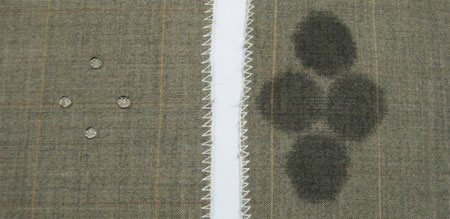| Posted: Oct 12, 2010 | |
Nanotechnology improves wool fabrics |
|
| (Nanowerk Spotlight) Nanotechnology shows great potential for revolutionizing the textile industry across its entire range of applications – medical, military, domestic, work, sports and clothing – with its ability to impart new functionality to textiles while at the same time maintaining their look and feel. The wool textile industry, for example, is researching the development of textiles with fast-absorbing and quick-drying properties. This has great importance for improving clothing thermophysiological comfort and wearing performance by adjusting the transport of heat and moisture through a fabric which was usually achieved using synthetic fibers. | |
| One stubborn hurdle that prevents nanotechnology-enabled 'smart' textiles from becoming more of a commercial reality is the insufficient durability of nanocoatings on textile fibers or the stability of various properties endowed by nanoparticles. Quite simply put, the 'smart' comes off during washing. | |
| "It still is a great challenge to graft functional inorganic nanoparticles onto the surface of wool fibers by a durable coalesce force" Dong Chen explains to Nanowerk. "Therefore, developing an effective approach to enhance the coalesce force between nanoparticles and wool fibers has great significance both in scientific and real applications of nanotechnology functionalized textiles." | |
| Chen is a materials scientist working at the Laboratory of Controllable Preparation and Application of Nanomaterials, Technical Institute of Physics and Chemistry, Chinese Academy of Sciences, and the The Institute of Textiles and Clothing at Hong Kong Polytechnic University. | |
| In previous work (see: "Nanotechnology wool fabric combines multifunctionality with comfort"), Chen and his team, led by professors Fangqiong Tang from the Technical Institute of Physics and Chemistry at CAS and Yi Li from The Institute of Textiles and Clothing, concluded that the stability of the modified wool fibers during washing did not yet meet our expectations. In their present work ("Fabrication of Fast-Absorbing and Quick-Drying Wool Fabrics with Good Washing Durability"), they adopted a simply and effective method to functionalize a reactive silane layer onto the surface of wool fibers by chemical bonding and then grafting an ultrathin silica nanoparticles layer via an in situ growth method. | |
| "The prepared wool fabrics show excellent fast-absorbing and quick-drying properties" says Chen. "More importantly, these properties can be maintained after washing 20 times, which paves the way for developing machine-washable wool textiles with great comfort and functionality." | |
| The video clip above shows the process of the absorption of water droplets on the superhydrophilic wool fabrics. In the video, the fabric on the left is a pristine wool fabric and the right is a silica-grafted wool fabric. The water absorption rates of the silica-grafted wool fabric are fast and the drip diffusion radii are large, which is of great importance to realize the fast absorbing and quick-drying of water or perspiration on the surface of human skin. | |
| Going beyond the thermophysiological comfort aspects, due to the strong immobilization through siloxane bonding, this silane modified reactive layer can be extended to bonding other functional nanoparticles as well. Furthermore, the in situ growth strategy shows great potential for chemically modifying other functional agents onto clothing fibers to achieve smart textiles with good washing durability as well as wearing comfort. | |
| The relatively simple fabrication approach consists of two steps. The first step is the functionalization of wool fibers by immersing the cleaned fibers into a silane solution and then drying for 20 minutes. This serves as an anchoring layer. The second step is grafting silica nanoparticles via a hydrolyzed reaction between the alkylsilane functionalities on the silanized wool fiber surface and tetraethoxysilane. | |
| Because the application of nanoparticles and surface modification of wool fibers are done in the same process, the finishing process is simplified. | |
 |
|
| Photographs of the absorption of water droplets on wool fabrics. Left: pristine wool fabric. Right: silica-grafted wool fabric. (Image: Dr. CHEN Dong) | |
| Chen notes that, with its fast-absorbing and quick-drying properties, this breathable wool fabric can keep your skin surface dry while not cling to skin; consequently, allowing you to feel fresh and comfortable even after your vigorous workout. "This has great potential in application of sportswear, travelwear, underwear, bedroom fabrics and summer garments." | |
| The research directions of the team are now focussed in two areas: 1) Establishing a practical platform to integrate multiple functions into a single textile system based on their silane grafting and in situ growth strategy; and 2) evaluating the biological safety of these modified textiles. | |
| "There are still many challenges in this research field, such as how to balance between the textile's new functions and their inherent advantages and how to establish a scientific system to evaluate the biological safety of nanotechnology modified textiles" says Chen. | |
 By
Michael
Berger
– Michael is author of three books by the Royal Society of Chemistry:
Nano-Society: Pushing the Boundaries of Technology,
Nanotechnology: The Future is Tiny, and
Nanoengineering: The Skills and Tools Making Technology Invisible
Copyright ©
Nanowerk LLC
By
Michael
Berger
– Michael is author of three books by the Royal Society of Chemistry:
Nano-Society: Pushing the Boundaries of Technology,
Nanotechnology: The Future is Tiny, and
Nanoengineering: The Skills and Tools Making Technology Invisible
Copyright ©
Nanowerk LLC
|
|
|
Become a Spotlight guest author! Join our large and growing group of guest contributors. Have you just published a scientific paper or have other exciting developments to share with the nanotechnology community? Here is how to publish on nanowerk.com. |
|
